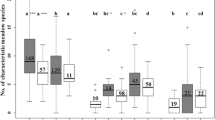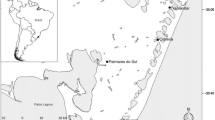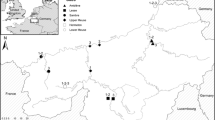Abstract
We tested the hypothesis that small rock-enclosed geologic refuges have an important role in maintaining grazing-sensitive species in grassland with a long history of intense grazing. The study was carried out in Mediterranean grassland in a basalt landscape in northern Israel. Community composition was compared in 63 sites between samples of 1 m2 quadrats in two microhabitats: (1) rock-enclosed, presumed “refuges” and (2) rock-adjacent, “near refuges” but just outside them, accessible to cattle grazing. Median refuge area was 2.75 m2, median rock height and diameter around refuges were 1.10 m and 1.50 m. Median height of residual dry herbage was 1.41 m in refuges, compared to 0.38 m outside, indicating the difference in grazing intensity. Species richness at three scales (quadrat, site, all sites) was significantly greater in the near-refuge than in the refuge habitat. In the latter, many annuals were excluded by dominance of tall perennials. Twelve species (of 103) had significantly higher cover in refuges, including tall perennial grasses, tall annuals, climbers, and a shrub. A total of 53 species with a strong significant negative response to refuges were mostly small and medium height annuals. The intermediate group of 38 species with weak or non-significant responses to refuges included, among others, dominant tall grasses that were abundant both in refuges and just outside them. The latter, as well as most refuge-positive species had shown a positive response to protection in exclosures. The results support the hypothesis that small rock-enclosed habitats—more so than artificial exclosures—are effective grazing refuges for rare, grazing-susceptible species. The contribution of refuges to species richness at the landscape scale is much greater than their proportion of the area. Dispersion from refuges maintains small populations of rare species near refuges and can initiate expansion into the landscape when grazing pressure is lowered.


Similar content being viewed by others
References
Axelrod DI (1985) Rise of the grassland biome, central North America. Bot Rev 51:163–201
Cingolani A, Noy-Meir I, Díaz S (2005) Grazing effects on rangeland diversity: a synthesis of contemporary models. Ecol Appl 15:757–773
Clements FE (1934) The relict method in dynamic ecology. J Ecol 22:39–68
Díaz S, Noy-Meir I, Cabido M (2001) Can grazing response of herbaceous plants be predicted from simple vegetative traits? J Appl Ecol 38:497–508
Díaz S, Lavorel S, McIntyre S, Falczuk V, Casanoves F, Milchunas D, Skarpe C, Rusch G, Sternberg M, Noy-Meir I, Landsberg J, Zhang W, Clark H, Campbell BD (2006) Plant trait responses to grazing – a global synthesis. Glob Change Biol 12:1–2
García LV (2004) Escaping the Bonferroni iron claw in ecological studies. Oikos 105:657–663
Gutman M, Seligman NG, Noy-Meir I (1990) Herbage production on Mediterranean grassland under seasonal and yearlong grazing. J Range Manage 43:64–68
Harlan JR, Zohary D (1966) Distribution of wild wheats and barley. Science 153:1074–1080
Larson F, Whitman W (1942) A comparison of used and unused grassland mesas in the badlands of South Dakota. Ecology 23:438–445
Larson DW, Matthes U, Kelly PE (1999) Cliffs as natural refuges. Am Sci 87:410–417
Larson DW, Matthes U, Kelly PE (2000) Cliff ecology: pattern and process in cliff ecosystems. Cambridge University Press, Cambridge, UK
Marquiss R, Lang R (1959) Vegetation composition and ground cover of two natural relict and their associated grazed areas in the red desert of Wyoming. J Range Manage 12:104–109
McPherson GR, Wright HA (1990) Effects of cattle grazing and Juniperus pinchotti canopy cover on herb cover and production in western Texas. Am Midl Nat 123:144–151
Milchunas DG, Noy-Meir I (2002) Grazing refuges, external avoidance of herbivory and plant diversity. Oikos 99:113–130
Milchunas DG, Noy-Meir I (2004) Geologic grazing refuges and grassland diversity: a shortgrass steppe study. J Range Manage 57:141–147
Milchunas DG, Lauenroth WK, Sala OE (1988) A generalized model of the effects of grazing by large herbivores on grassland community structure. Am Nat 132:87–106
Moran MD (2003) Arguments for rejecting the sequential Bonferroni in ecological studies. Oikos 100:403–405
Noy-Meir I (1990) The effects of grazing on the abundance of wild wheat, barley and oat. Biol Conserv 51:299–310
Noy-Meir I (1996) The spatial dimensions of plant-herbivore interactions. In: West NE (ed) Rangelands in a sustainable biosphere. Proc 5th International Rangeland Congress. Society for Range Management, Denver, pp 152–154
Noy-Meir I (2001) Ecology of wild emmer wheat in Mediterranean grasslands in Galilee. Israel J Plant Sci 49S:43–52
Noy-Meir I, Sternberg M (1999) Grazing and fire response, and plant functional types in Mediterranean grasslands. In: Eldridge D, Freudenberger D (eds) People and rangelands: building the future, vol. 2. Proc 6th International Rangeland Congress, Townsville, pp 916–921
Noy-Meir I, Gutman M, Kaplan Y (1989) Responses of Mediterranean grassland plants to grazing and protection. J Ecol 77:290–310
Noy-Meir I, Agami M, Anikster Y (1991a) Changes in the population density of wild emmer wheat (Triticum turgidum var. dicoccoides) in a Mediterranean grassland. Israel J Bot 40:385–395
Noy-Meir I, Agami M, Cohen E, Anikster Y (1991b) Floristic and ecological differentiation of habitats within a wild wheat population at Ammiad. Israel J Bot 40:63–384
Proulx M, Mazumder A (1998) Reversal of grazing impact on plant species richness in nutrient-poor vs. nutrient rich ecosystems. Ecology 79:2581–2592
Rebollo S, Milchunas DG, Noy-Meir I, Chapman PL (2002) The role of a spiny plant refuge in structuring grazed shortgrass steppe communities. Oikos 98:3–64
Rebollo S, Milchunas DG, Noy-Meir I (2005) Refuge effects of a cactus in grazed short-grass steppe. J Veg Sci 16:85–92
Shitzer D (2004) The role of natural grazing refuges in conservation of species diversity in grassland communities. Ph.D. Thesis, Faculty of Agriculture, Hebrew Univ. Jerusalem (in Hebrew, English summary)
Smith BD (1995) The emergence of agriculture. Scientific American Library, New York
Stebbins GL (1981) Coevolution of grasses and herbivores. Ann Missouri Bot Gardens 68:75-86
Sternberg M, Gutman M, Perevolotsky A, Ungar ED, Kigel J (2000) Vegetation response to grazing management in a Mediterranean herbaceous community: a functional group approach. J Appl Ecol 37:224–237
Westoby M (1998) A leaf-height-seed (LHS) plant ecology strategy scheme. Plant Soil 199:213–227
Westoby M (1999) The LHS strategy scheme in relation to grazing and fire. In: Eldridge D, Freudenberger D (eds) People and rangelands: building the future, vol 2. Proc 6th International Rangeland Congress, Townsville, pp 893–896
Zohary D, Brick Z (1961) Triticum dicoccoides in Israel: notes on its distribution, ecology and natural hybridization. Wheat Inf Serv 13:6–8
Zohary M, Feinbrun-Dothan N (1966–1986) Flora Palaestina. Parts I–IV. Israel Academy of Sciences and Humanities, Jerusalem
Acknowledgments
This work was part of the Ph.D. thesis of the first author and was funded by the US-Israel Binational Science Foundation (BSF 96-00112) and NSF DEB00-87255. We are grateful to Yoram Canetti for his essential help in fieldwork.
Author information
Authors and Affiliations
Corresponding author
Rights and permissions
About this article
Cite this article
Shitzer, D., Noy-Meir, I. & Milchunas, D.G. The role of geologic grazing refuges in structuring Mediterranean grassland plant communities. Plant Ecol 198, 135–147 (2008). https://doi.org/10.1007/s11258-007-9391-9
Received:
Accepted:
Published:
Issue Date:
DOI: https://doi.org/10.1007/s11258-007-9391-9




